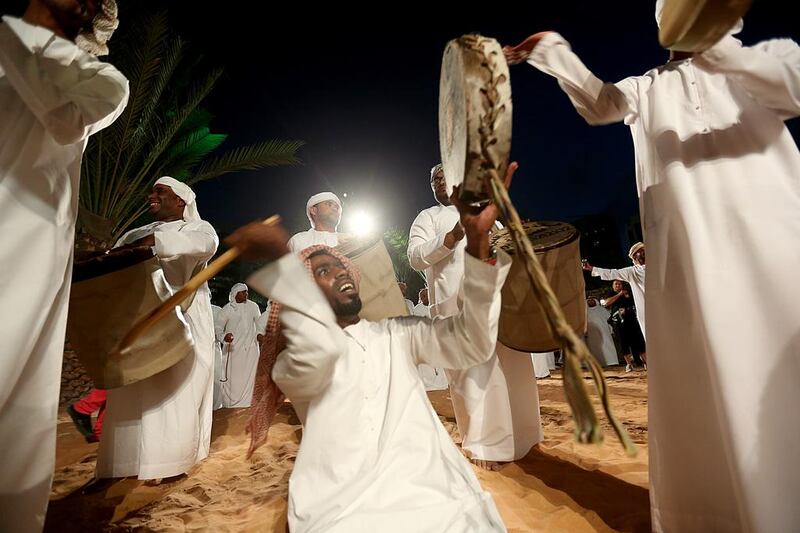ABU DHABI // Sheikh Mohammed bin Zayed, Crown Prince of Abu Dhabi, led an impressive, exuberant parade into the walls of Qasr Al Hosn on Thursday to officially launch the festival honouring the birthplace of the capital.
Thousands had trooped into the historic fort for the start of the 10-day festival as dozens of traditional Yola dancers performed against the setting sun.
Sheikh Mohammed, also Deputy Supreme Commander of the Armed Forces, had led the parade from Al Manhal Palace.
The march symbolised the Baniyas tribe’s journey from Liwa to Abu Dhabi where they built the historic fort in the 1700s. Part of the fort will open to visitors for the first time in years during the festival.
Butti Al Muhairi, spokesman for the Abu Dhabi Tourism and Culture Authority (TCA) team that organised the event, said they were honoured to have Sheikh Mohammed visit the festival.
“Everyone’s happy. Everyone enjoyed it. Everyone remembered old times,” said Mr Al Muhairi.
The festival opened to select visitors only on Thursday. It will be open for women and children younger than 12 on Friday, then to the general public on Saturday.
The main attraction is the Cavalia at Qasr Al Hosn show, which has been adapted for the festival. Tickets start from Dh250 for adults and Dh150 for children. Near the Marine section of the festival’s four main areas was a manmade pond, with old-fashioned boats docked and volunteers making nets and reminiscing on its shores.
One of them was Salem Al Suri, 56, who said he had learnt to make nets over the past 40 years, taught by his father and grandfathers in Ras Al Khaimah.
Nearby, another volunteer told of how he used to free-dive as deep to 35 metres to search for pearls, telling his story while tying together a fishing net using his feet.
He said he could hold his breath for as long as four minutes on a single dive.
Another booth set up by the Environment Agency Abu Dhabi demonstrated old pearling techniques and tools, such as nose plugs made from turtle and goat bone, and leather finger gloves to protect the hands while searching through rocks.
A specialist taught new techniques for pearl aquaculture, showing visitors how to insert a nucleus inside an oyster to stimulate the growth of a pearl.
University students, called “festival ambassadors”, were present to explain the process to visitors and were stationed throughout the festival grounds.
Across the walkway, five eagles perched where Al Ain Zoo had set up the area for its bird show.
Faisal Al Hammadi, supervisor of bird training at the zoo, said he brought four different breeds – two steppe eagles, a short-toed eagle, a white-tailed sea eagle and a golden eagle, which he said is the most powerful type in the UAE.
“These birds are our stars at the zoo,” Mr Al Hammadi said.
The zoo also brought five falcons in a show to celebrate the birds’ role in Emirati culture and the desert tradition. Their trainers will also educate visitors about the wildlife conservation.
The tradition came to the Arabian Gulf from Mongolia in the sixth century, said Mr Al Hammadi, who has worked with birds for 15 years. Eagles, not falcons, were originally used.
“But the Arabic countries took it to hunt for food and to have fun,” he said.
Mr Al Hammadi said falconry not only provided food, but also taught respect for animals and humans.
“In the past, these are very important for food and to teach young people how they can be patient and deal with animals,” he said, adding that it took time to teach a bird how to hunt.
“This will teach young people how they can be patient and wait to get what he want. This is the most important lesson from falconry.”
Walking through the other areas of the festival grounds – Oasis, Desert, and Abu Dhabi Island and the Fort – people sold handcrafts such as bags, perfume and incense.
The scents wafted through the air as traditional music and sounds of a bustling market played through speakers. Other stalls sold novelty items such as old radios and records or jars of locally made honey.
In the Cultural Foundation next to Qasr Al Hosn, a gahwa has been set up to represent a contemporary take on classic coffee. Workshops have been set up in the book centre, staffed by university volunteers and organised by TCA.
Fatima Ghazal, workshop officer at the TCA education department, described the different workshops available, among them perfume, incense and doll-making. In another area, volunteers will educate people about traditional dress.
At one station, visitors can make jewellery from burqas and burqas from jewellery.
“It’s really difficult to make a burqa,” Ms Ghazal said.
People can sign up to participate in the workshops for free at the festival information booths.
Volunteers are also teaching visitors about traditional Julfar pottery made in the UAE since the 11th century. The last piece was made in 1950 and shares its name with an early name for RAK.
The festival runs until March 1 and is open from 4pm to 11pm.
Lectures about Qasr Al Hosn will be given, including one called Qasr Al Hosn: The Oldest Political Symbol, on Saturday from 7pm to 8pm.
Tours of the fort are available on a first-come, first-serve basis to small groups in both Arabic and English, from 4.15pm to 10.30pm.
Other events at the festival include documentary screenings and performances of poetry and music.
This year is the second annual instalment of the festival.






